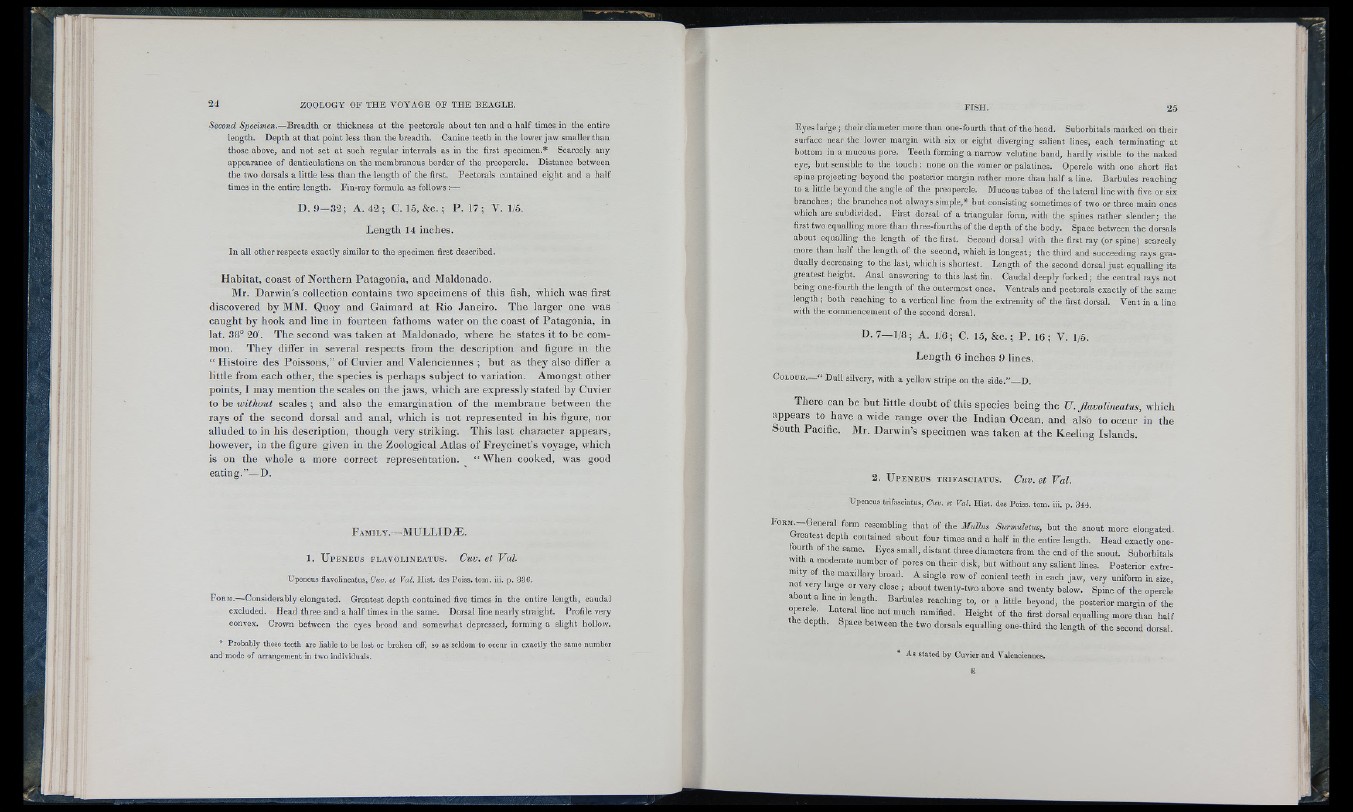
Second Specimen.— Breadth or thickness a t the pectorals about ten and a half times in the entire
length. D epth a t that point less than the breadth. Canine teeth in the lower jaw smaller than
those above, and not set at such regular intervals as in the first specimen.* Scarcely any
appearance of denticulations on the membranous border of the preopercle. Distance between
the two dorsals a little less than the length of the first. Pectorals contained eight and a half
times in the entire length. Fin-ray formula as follows:—
D. 9—32; A. 42 ; C. 15, & c.; P . 17 ; V. 1/5.
Length 14 inches.
In all other respects exactly similar to the specimen first described.
Habitat, coast of Northern Patagonia, and Maldonado.
Mr. Darwin’s collection contains two specimens of this fish, which was first
discovered by MM. Quoy and Gaimard at Rio Janeiro. The larger one was
caught by hook and line in fourteen fathoms water on the coast of Patagonia, in
lat. 38° 20'. The second was taken at Maldonado, where he states it to be common.
They differ in several respects from the description and figure in the
“ Histoire des Poissons,” of Cuvier and Valenciennes ; but as they also differ a
little from each other, the species is perhaps subject to variation. Amongst other
points, I may mention the scales on the jaws, which are expressly stated by Cuvier
to be without scales ; and also the emargination of the membrane between the
rays of the second dorsal and anal, which is not represented in his figure, nor
alluded to in his description, though very striking. This last character appears,
however, in the figure given in the Zoological Atlas of Freycinet’s voyage, which
is on the whole a more correct representation. “ When cooked, was good
eating.”—D.
F amily.-M U L L ID ^ .
1. U p e n e u s f l a v o l in e a t u s . Cuv. et V al
Upeneus flavolineatus, Cuv. et Val. Hist, des Poiss. tom. iii. p. 336.
F o rm .— Considerably elongated. Greatest depth contained five times in the entire length, caudal
excluded. Head three and a half times in the same. Dorsal line nearly straight. Profile very
convex. Crown between the eyes broad and somewhat depressed, forming a slight hollow.
* Probably these teeth are liable to be lost or broken off, so as seldom to occur in exactly the same number
and mode of arrangement in two individuals.
Eyes larg e; their diameter more than one-fourth that of the head. Suborbitals marked on their
surface near the lower margin with six or eight diverging salient lines, each terminating at
bottom in a mucous pore. Teeth forming a narrow velutine band, hardly visible to the naked
eye, but sensible to the to u ch : none on the vomer or palatines. Opercle with one short flat
spine projecting beyond the posterior margin rather more than h alf a line. B arbules reaching
to a little beyond the angle of the preopercle. Mucous tubes of the lateral line with five or six
branches; the branches not always simple,* but consisting sometimes of two or three main ones
which are subdivided. First dorsal of a triangular form, with the spines rather slender; the
first two equalling more than three-fourths of the depth of the body. Space between the dorsals
about equalling the length o f the first. Second dorsal with the first ray (or spine) scarcely
more than h alf the length of the second, which is longest; the third and succeeding rays gradually
decreasing to the last, which is shortest. Length of the second dorsal ju st equalling its
greatest height. Anal answering to this last fin. C audal deeply forked; the central rays not
being one-fourth the length of the outermost ones. V entrals and pectorals exactly o f the same
length ; both reaching to a vertical line from the extremity of the first dorsal. V ent in a line
with the commencement of the second dorsal.
D. 7— 1/8; A. 1/6; C. 15, & c.; P. 16; V. 1/5.
Length 6 inches 9 lines.
C o l o u r .— “ D ull silvery, with a yellow stripe on the side.”— D.
There can be but little doubt of this species being the U. JiavoUneatus, which
appears to have a wide range over the Indian Ocean, and also to occur in the
South Pacific. Mr. Darwin’s specimen was taken at the Keeling Islands.
2 . U p e n e u s t r i f a s c i a t u s . C uv. et Val.
Upeneus trifasciatus, Cuv. et Val. Hist, des Poiss. tom. in. p. 344.
F O E IU -G enerd form resembling that of the M ullus S urm u ktm , but the snout more elongated.
Greatest depth contained about four times and a half in the entire length. Head exactly one-
ourth of the same. Eyes small, distant three diameters from the end of the snout. Suborbitals
with a moderate number of pores on their disk, but without any salient lines. Posterior extremity
of the maxillary broad. A single row of conical teeth in each jaw , very uniform in size,
no very large or very close ; about twenty-two above and twenty below. Spine of the opercle
about a line m length. Barbules reacbing to, or a little beyond, the posterior margin of the
opercle Lateral hne not much ramified. H eight of the first dorsal equalling more than half
e ep 1. bpace between the two dorsals equolliiig one-third the length of the second dorsal.
As stated by Cuvier and Valenciennes.
E